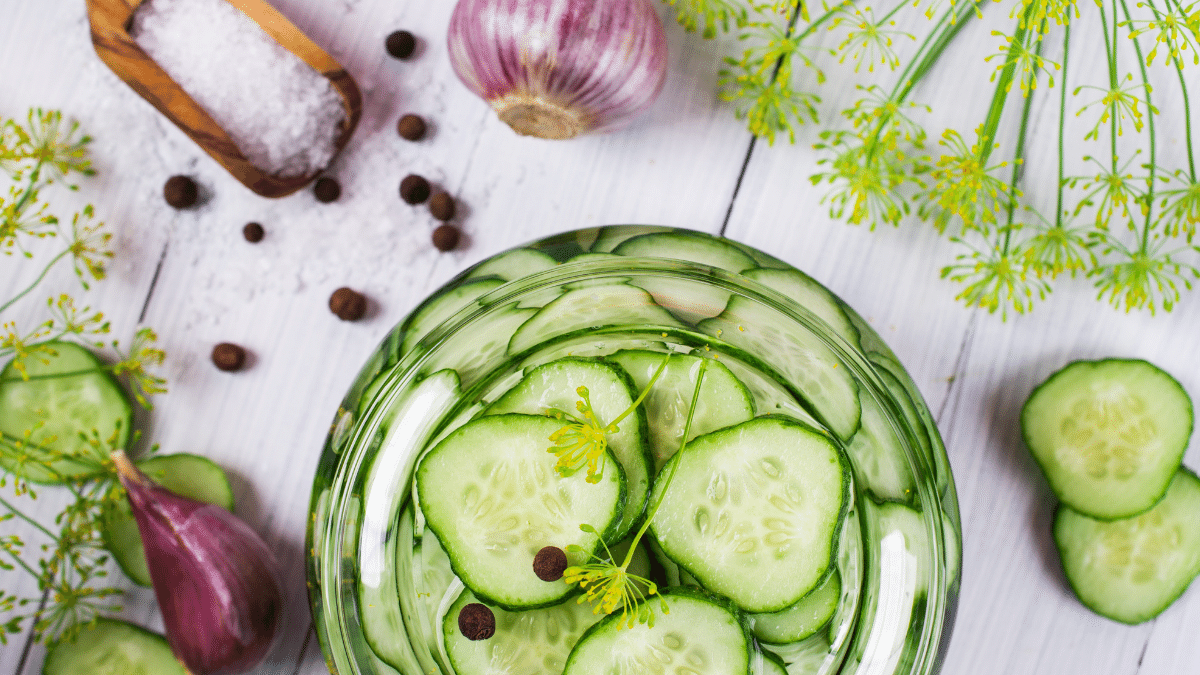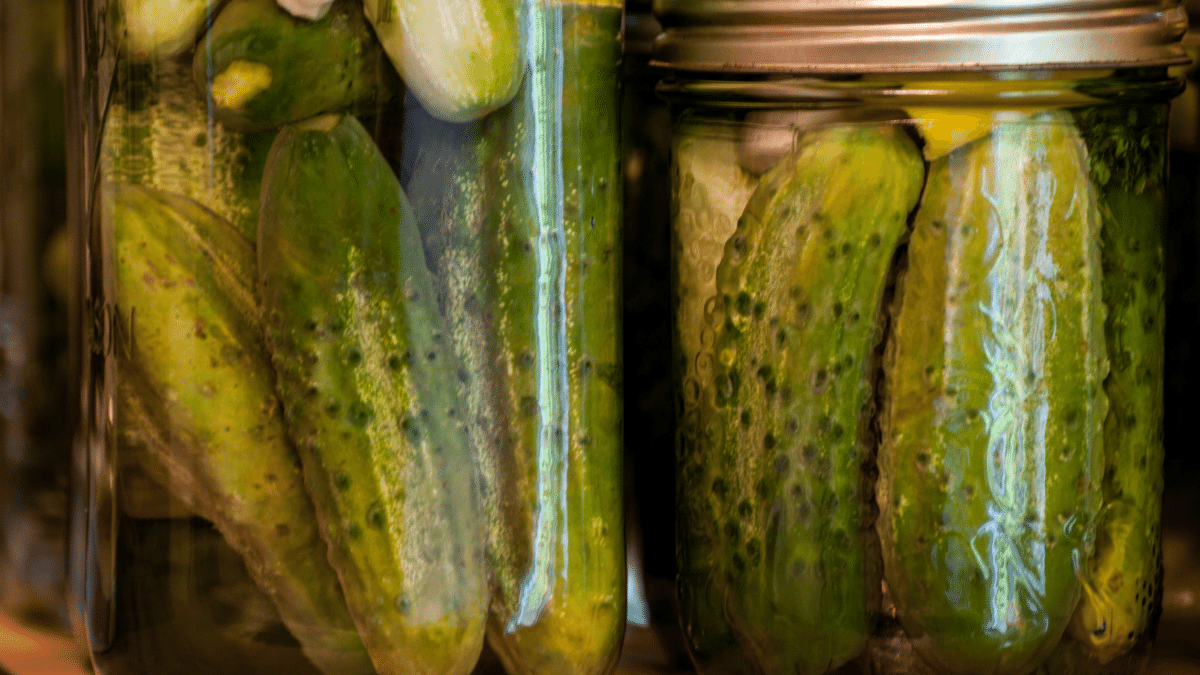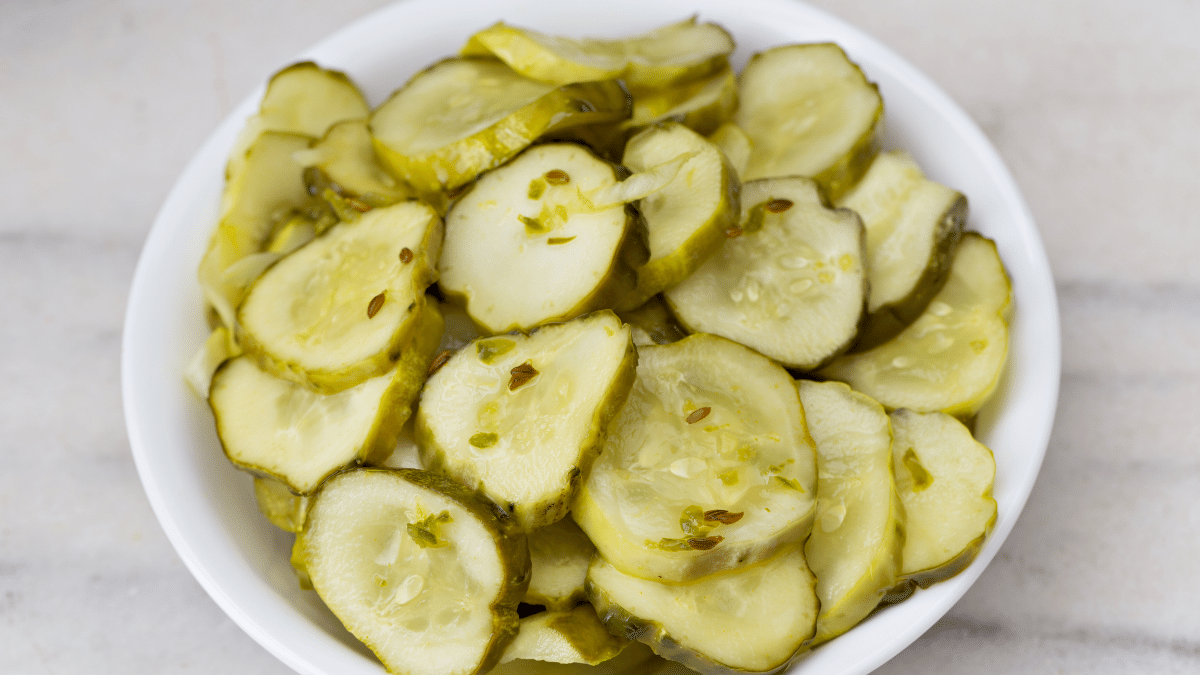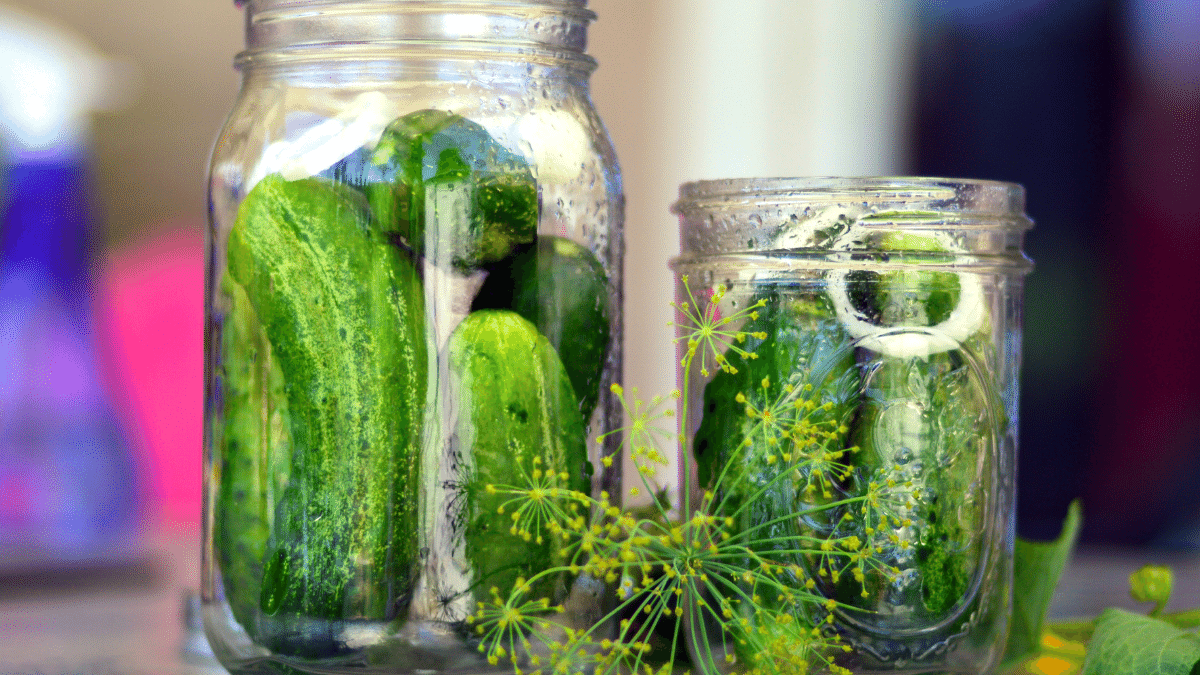
Cucumbers are some of the best kitchen staples to grow yourself! They are really easy to propagate, and when the plants do well, you can find yourself with mountains of cucumbers to get through the season! They are perfect for salads, appetizers, and even drinks. If you’re like me, you will find yourself with a few too many cucumbers and not much left to do with them. Have you thought about looking into canning ideas for cucumbers?
Canning cucumbers is quick, easy, and keeps your produce tasting great for months to come. Canned pickles are also budget-friendly, eco-friendly, and will last you for ages – and there are plenty of canning recipes for cucumbers out there worth following.
In this guide, I’ll take you through the basics of why cucumber canning is worth your time, and a few of quick canning ideas you can put to work right now.
How long can canned cucumbers last?
Fresh, canned cucumbers can stay in the fridge for about a week. However, as you know, pickles tend to have a much longer shelf life.
As long as you follow strict pickling guidelines, your preserved cucumbers should be safe to keep in the cupboard for up to about a year.
Of course, the shelf life of your efforts also depends on the types of pickles that you plan on making. Some might only last a few months, whereas others will last past a year. Either way, pickles definitely stay good for a long time!
Once they are opened, you should have a few weeks to a few months to eat them safely, but you must remember to keep them refrigerated once opened.
It’s pretty easy to tell if your cucumbers or pickles are going bad. To start with, there will be a nasty smell – fermentation can really kick up a stink! Your pickles will also likely start to change color, i.e., they’ll get darker if fungi is starting to grow. The same goes for the texture of the brine or water you can with.
You may even start to see your canning jars starting to bulge, or that bubbles are floating up to the surface. If bubbling is occurring and the jars have been left to ferment without shaking, your cucumbers are probably on the way out.
Do canned cucumbers have to be refrigerated?
Canned cucumbers can be refrigerated, but it’s not essential.
Canned fresh cucumbers will need to be refrigerated to maintain their crunch and texture, but pickles can be kept in a cupboard. In fact, while the jar is still unopened, in most cases, it is best to keep your pickles in a cool, dry area, such as in your cupboards or pantry.
Once the pickles are opened, it is best to keep them in the fridge until they are all eaten. Remember to tighten the lid on the jar every time you close it to maintain the quality of the contents, and keep them in the back of your fridge until you are ready to eat them again!
You can prolong the shelf life of your pickles if you keep them properly, which means knowing when to keep them out and when to put them in the fridge.
Canning your cucumbers – what you’ll need
Before I get into a couple of my favorite canning cucumber recipes, it’s worth taking stock of some of the equipment and ingredients you’ll need. If you’re already into your canning, it’s likely you’ll have some jars to hand – but it’s always best to be prepared.
Recipes and their specific ingredients will, of course, vary. However, it’s just as well to have the following to hand regardless of how you intend to can those cucumbers.
- Cucumbers (obvious, much?)
- Canning jars (mason jars are ideal)
- Canning salt
- Bay leaf
- A large bowl and canning pot
- Dill (either seed, leaf, or even both) and dill weed
- Mustard seed
- Pepper flakes (red, ideally)
- Apple cider vinegar
- Granulated sugar
- Ground cloves
- Peppercorns (black)
- Turmeric
- Red and green bell peppers
- Red and yellow onions
- A dish towel or similar
- A cooler
- Vinegar (usually white wine or rice works best)
It’s worth remembering that, when canning and preserving cucumbers, you’re essentially going to be making pickles – so if you like adding a bit of tanginess to your sandwiches, you’re in the right place.
For the purpose of this guide, I’m going to assume you already know how to can, and that you have a process in place. If you’re completely new to canning, don’t worry!
Be sure to read up on a quick tutorial to getting started – and always make sure you’ve sterilized your jars properly before you begin! While you can expect your canned cucumbers to last for months and months to come, it stands to reason you won’t want any nasty bacteria creeping into the mix along the way.
Canning cucumber recipes – things to try
Unfortunately, there aren’t scores of different cucumber canning recipes out there – but there are a few different twists on how to produce different flavors and textures. Below, I’ve lined up a few popular canning cucumber recipes that are nice and easy to start with. Try them yourself!
Dill pickles

Dill pickles are a go-to for anyone who cans cucumbers. They are the easiest pickles to make and have the perfect flavor to garnish any meal – salads, sandwiches, burgers, you name it.
To make the best dill pickles in the world, you need to start by boiling a mixture of vinegar, water, and salt in a pot.
While it is boiling, slice your cucumbers at the top and bottom to give them plenty of extra space in the jar. You will need half an inch of space between the tops of the pickles and the top of the jar. Then, slice your pickles either lengthways or horizontally, depending on how you want them.
Take your mason jars, and put in two cloves of garlic, two sprigs of dill, and all the cucumbers you can fit into the jar!
Once the mixture in the pot has boiled, carefully pour it into the jars. Do not close the jars until the brine has reached about room temperature.
As soon as the mixture has cooled down, you can place the lids on the pickles and put them in the fridge. They will be good to eat for about three months! You can start eating them right away but give the mixture about a week to settle, and your pickles will taste a lot better.
Bread and butter pickles

Bread and butter pickles are another staple in the pickling world. But what’s the difference between these canned cucumbers and the dill pickles we’ve seen above? It’s to do with seeds and spices.
Start by washing the cucumbers and cutting them into quarter-inch slices.
Put half a cup of your chosen pickling or canning salt, your cucumber slices, one diced yellow onion, one diced green bell pepper, and one diced red bell pepper into a clean bucket or large bowl. Stir the mixture together well, ensuring that the salt fully coats the other ingredients.
Put your bowl into a cooler and place a clean towel over the top. Put some ice gently on the towel, ensuring that it does not touch any of the cucumbers you wish to pickle. Then, place more ice around the cooler itself, leaving it for roughly three hours in a cool area – four hours may be necessary. It’s a waiting game!
After this time’s elapsed, simply drain the cucumbers, then place them somewhere clean on one side.
Now – it’s brine time. You can start to make the brine by boiling around seven cups of white vinegar, six cups of granulated sugar, half a teaspoon of ground cloves, one tablespoon of mustard seeds, two teaspoons of celery seed, and one and a half teaspoons of turmeric together in a pot on high heat.
Put the same number of cucumbers, peppers, and onions into each jar, pushing down on the ingredients so that they do not rise too high once the brine is poured on top.
Cover the cucumbers with the brine, leaving about half an inch at the top.
Leave the jars to cool down completely before closing them. Ideally, the jars should be processed in a boiling water canner for up to ten minutes before being left to cool down.
Keep the jars in a cool, dry place, where they can stay for up to a year! Once opened, keep them in the fridge, at which point they will be safe to eat for the next three months.
Canning cucumbers with low salt

If you’re trying to cut down on the salt in your diet, but still want to make the most of canning cucumbers to enjoy at a later date, then great news – Ball, the mason jar provider, has created a fantastic recipe to help you pickle up without the extra sodium. Below, I’ve provided a quick overview on Ball’s own guide.
You’ll need sugar, a small amount of salt, vinegar, dill, pickling spice, and – of course – your cucumbers. Firstly, prepare your jars in heated water (without boiling), using a boiled canner. You’ll need to wash and slice up your cucumbers so they’re a quarter thick.
Then add two tablespoons of salt and your spice, around six cups vinegar, and three cups sugar to a pan. You’ll ideally need to bag and tie your spices. Boil up and reduce, simmering for 15 minutes, and taking the bag out.
Start canning your cucumbers with a half-inch space where you’ll pack dill and pour hot water. You’ll then need to follow your standard canning process, popping in a boiled canner for another 15 minutes. Remove, cool, and you’re good to go within 24 hours.
This is a great little recipe that should help you prepare and preserve tasty pickles without having to go overboard on salt. Canning salt isn’t always essential for canning and pickling in any case – it’s more to do with flavor than anything else! Don’t be afraid to cut back a little bit if you need to.
Conclusion
If your cucumber plants have run rampant and you have more fruit than you can shake a (green) stick at, get yourself out of a pickle by making some… pickles!
Learning how to pickle cucumbers will help to provide for tasty green fillings for all kinds of meals for the years to come. With a bit of careful canning, they might just become your new favorite ingredients, and soon enough, you won’t remember what your burgers or salads tasted like without them!
As always with hot canning, it pays to tread carefully. Follow recipes and safety precautions to the letter. For example, it is always best to keep your jars in warm water, letting them heat up before the boiling brine is poured in. That way, you will reduce the temperature shock and avoid the risk of the jars cracking or breaking with the boiling brine.
It’s worth exploring other canned cucumber recipes across the web and social media for interesting twists on the basics – and I hope the recipes I’ve provided above offer you some food for thought!
Originally posted 2022-06-16 19:10:24.
